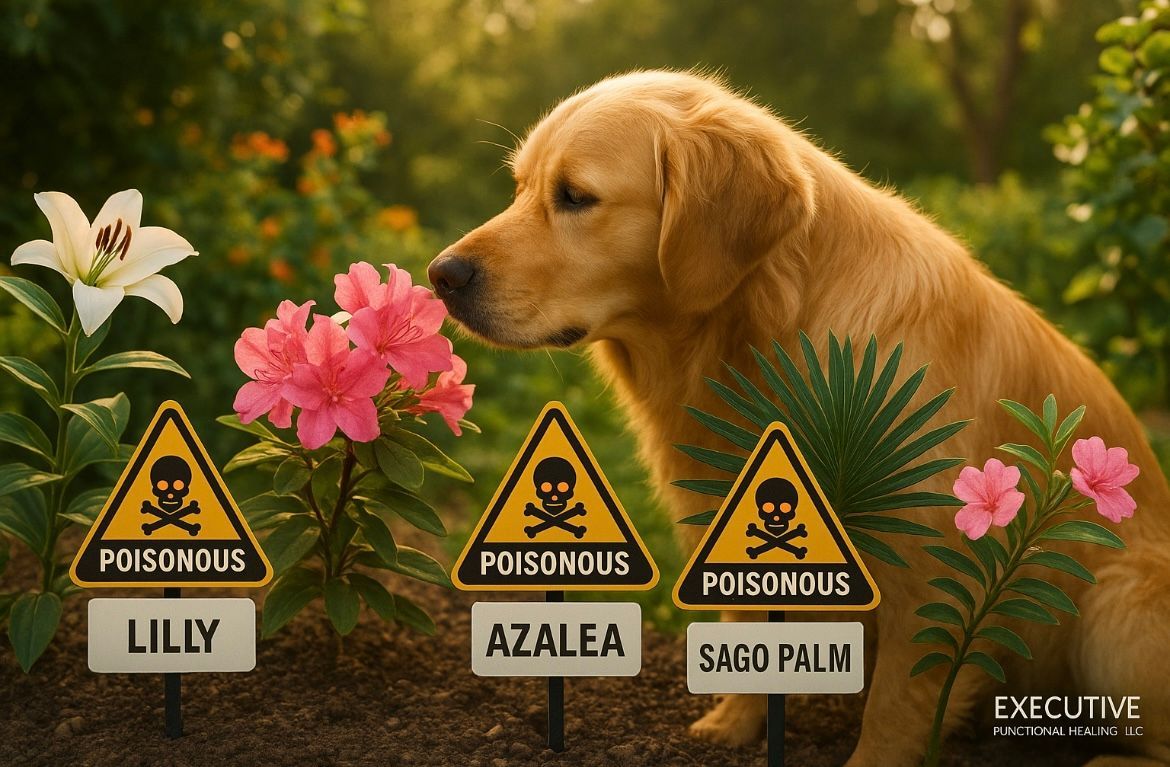15 Common Plants That Are Poisonous to Dogs (and What to Grow Instead)
Protect your pup from hidden dangers in your yard by learning which common plants are toxic to dogs and safe alternatives to plant instead.
Your backyard might look like a peaceful oasis but for your dog, it could be a hidden danger zone. Many well-known plants that brighten up gardens across America are surprisingly toxic to dogs. Even a curious sniff or chew can lead to vomiting, seizures, liver failure, or worse.
As a functional healing practitioner who believes in prevention over prescriptions, I always encourage pet owners to be just as mindful of their dogs’ environment as they are of their food. So let’s uncover the 15 most common plants that could be silently harming your dog and what you can plant instead for peace of mind.
Top 15 Poisonous Plants to Dogs (According to the ASPCA):
- Sago Palm – Extremely toxic. Can cause liver failure and death.
- Oleander – Even a few leaves can be fatal.
- Azalea/Rhododendron – Can cause vomiting, diarrhea, and heart failure.
- Lily of the Valley – Heart rhythm problems, vomiting, and seizures.
- Autumn Crocus – Causes organ damage within hours.
- Tulips & Daffodils (Bulbs) – Nausea, drooling, and heart issues.
- Foxglove – Disrupts heart function. Highly toxic.
- Castor Bean Plant – Contains ricin. One of the most toxic plants for dogs.
- Cyclamen – Especially toxic if the tubers are ingested.
- Dieffenbachia (Dumb Cane) – Irritates mouth and throat. May cause breathing problems.
- Philodendron – Oral pain and swelling.
- Tomato Plant (unripe parts) – Weakness, confusion, and slow heart rate.
- Amaryllis – Causes tremors, vomiting, and hypotension.
- English Ivy – Vomiting, abdominal pain, and diarrhea.
- Yew (Japanese, English) – Sudden death due to heart failure.
Safe and Dog-Friendly Alternatives to Grow Instead:
If you want a pet-safe yard that still looks beautiful, consider replacing toxic plants with these:
- Rosemary – Great for dogs and repels pests.
- Marigolds – Cheerful and non-toxic.
- Sunflowers – Big, bright, and safe.
- Basil, Thyme, Sage – Pet-safe herbs that double as healing additions to your kitchen.
- Spider Plants – Safe and air-purifying indoors.
- Camellia – A gorgeous shrub that’s non-toxic to dogs.
Why This Matters More Than You Think:
Symptoms of plant toxicity can show up fast or go unnoticed until it’s too late. If your dog has unexplained digestive issues, skin reactions, or changes in behavior, hidden plant toxins could be the culprit.
Most conventional vets treat symptoms. But root-cause healing means looking at everything in your dog’s world including what they sniff, eat, or brush up against outside.
Client Story:
One of my clients came to me with a dog experiencing mysterious seizures. The vet wanted to prescribe heavy anti-seizure medication. But after investigating the dog’s environment, we discovered the family had recently landscaped with sago palms. Once the plants were removed and detox support was started, the seizures stopped entirely.
Healing is rarely random. There’s always a cause.
Final Tips for Pet Parents:
- Always check new plants on the ASPCA Toxic Plant List before planting.
- Avoid leaving cut flowers or plant clippings around.
- Dogs often chew out of boredom, stress, or nutrient deficiency—addressing the root cause can prevent this behavior.
Want holistic help for your dog’s health?
Visit www.executivefunctionalhealing.com or join my private Facebook group: Executive Healing Circle where we talk real symptoms, real solutions, and root-cause healing—for humans and pets alike.

